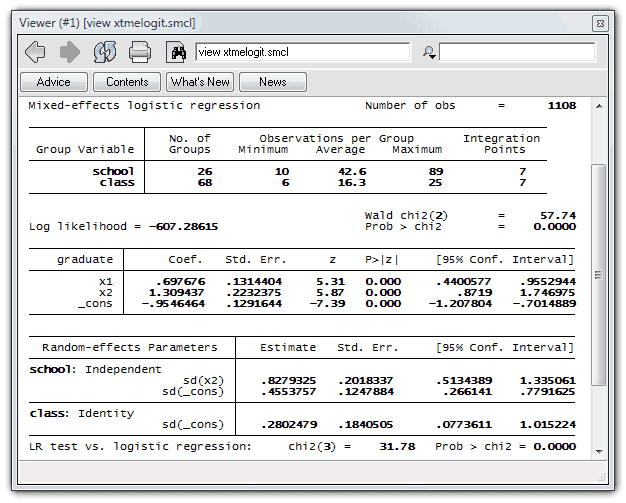

Updates to multilevel mixed models for binary and count responses were introduced in Stata 10.
|
| Order |
Stata’s new mixed-models estimation routines xtmelogit and xtmepoisson make it easy to fit two-way, multiway, multilevel, and hierarchical random-effects models on binary and count data.
To fit a model of graduation with fixed coefficient on x1 and random coefficient on x2 at the school level, and with random intercepts at both the school and class-within-school level, you type
. xtmelogit graduate x1 x2 || school: x2 || class:

The results show that the average coefficient across schools on x2 is 1.31 with standard deviation .83. There is also a significant overall effect due to school and a somewhat significant effect due to class. The LR test shows that the three random effects, taken together, provide a substantially better fit than does standard (marginal) logistic regression.
Estimation is by ML, and standard errors and confidence intervals (in fact, the full covariance matrix) are estimated for all variance components.
xtmelogit and xtmepoisson provide four random-effects variance structures—identity, independent, exchangeable, and unstructured—and you can combine them to form even more complex block-diagonal structures.
predict after xtmelogit and xtmepoisson will calculate predicted random effects.
For a complete list of what’s new in longitudinal/panel-data analysis, click here.
Learn
Free webinars
NetCourses
Classroom and web training
Organizational training
Video tutorials
Third-party courses
Web resources
Teaching with Stata
© Copyright 1996–2026 StataCorp LLC. All rights reserved.
×
We use cookies to ensure that we give you the best experience on our website—to enhance site navigation, to analyze usage, and to assist in our marketing efforts. By continuing to use our site, you consent to the storing of cookies on your device and agree to delivery of content, including web fonts and JavaScript, from third party web services.
Cookie Settings
Last updated: 16 November 2022
StataCorp LLC (StataCorp) strives to provide our users with exceptional products and services. To do so, we must collect personal information from you. This information is necessary to conduct business with our existing and potential customers. We collect and use this information only where we may legally do so. This policy explains what personal information we collect, how we use it, and what rights you have to that information.
These cookies are essential for our website to function and do not store any personally identifiable information. These cookies cannot be disabled.
This website uses cookies to provide you with a better user experience. A cookie is a small piece of data our website stores on a site visitor's hard drive and accesses each time you visit so we can improve your access to our site, better understand how you use our site, and serve you content that may be of interest to you. For instance, we store a cookie when you log in to our shopping cart so that we can maintain your shopping cart should you not complete checkout. These cookies do not directly store your personal information, but they do support the ability to uniquely identify your internet browser and device.
Please note: Clearing your browser cookies at any time will undo preferences saved here. The option selected here will apply only to the device you are currently using.